In the early hours of May 7, India launched 14 air strikes at targets in Pakistan’s Punjab province and Azad Jammu and Kashmir (AJK). The offensive, christened Operation Sindoor, was launched as “retaliation” for the April 22 attack on Indian tourists in Pahalgam, located in Indian-administered Kashmir.
At a special news briefing held later that morning, Indian government and military officials claimed the strikes were “focused on dismantling terrorist infrastructure and disabling militants likely to be sent across to India.” In his May 12 address, India’s Prime Minister Narendra Modi claimed “more than 100 dreaded terrorists” had been killed in these attacks. Senior Indian officials and other prominent Indian voices, both before Modi’s address and after it, repeatedly described the strikes as “calibrated, measured, non-escalatory, proportionate, and responsible.”
The reality on the ground, however, told a starkly different story. According to local authorities, eyewitnesses, and verified photos and videos from the affected areas, the strikes primarily targeted mosques situated in densely populated residential neighborhoods. Far from being “measured” and “calibrated,” the attacks resulted in the deaths of at least 40 civilians, including seven women and 15 children. Another 121 people were injured, among them 10 women and 27 children. Subsequent reporting revealed none of the casualties had any links to militant groups, contrary to New Delhi’s claims.
Curiously, India has yet to present any verifiable evidence linking the perpetrators of the Pahalgam attack — the stated justification for launching Operation Sindoor — to Pakistan. Although New Delhi has attributed the attack to The Resistance Front, a little-known group it claims is an offshoot of Lashkar-e-Taiba, it has so far failed to apprehend any of those responsible, even a month after the incident.
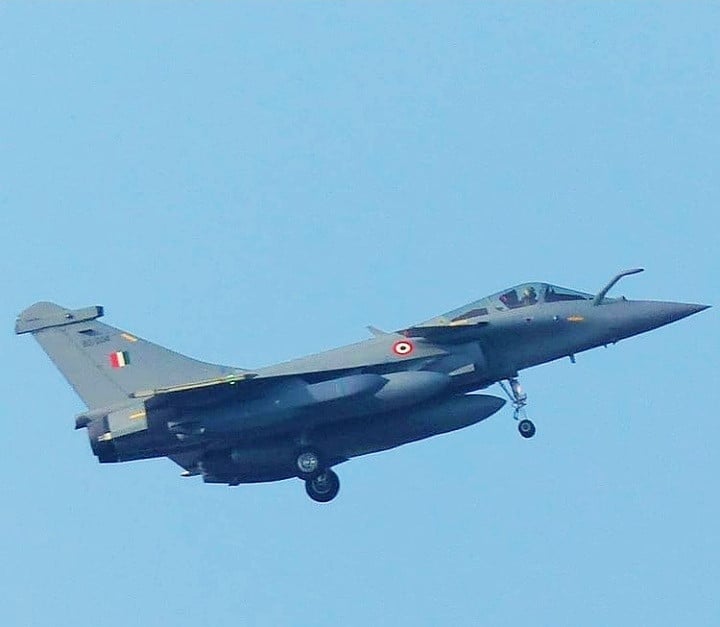
Exported escalation
What makes the incident particularly explosive, however, is not only India’s breach of Pakistan’s sovereignty on such tenuous grounds, but also its alleged use of European-made weapon systems in strikes that caused civilian casualties and brought the region to the brink of all-out war between two nuclear-armed states.
Although India has not officially disclosed which weapons were used in the May 7 air strikes, reports in Indian media citing security sources and open source intelligence suggest that at least some of the strikes on Pakistani soil involved SCALP-EG cruise missiles. These missiles, developed jointly by France and the UK under the MBDA consortium, were reportedly launched from the Indian Air Force’s newly acquired Rafale multirole fighter jets manufactured by Dassault Aviation.
In its immediate response to the May 7 strikes, the Pakistan Air Force announced it shot down six IAF jets, including three Rafale fighters. Photo evidence of at least one downed Rafale — specifically a tail fragment bearing the IAF serial number “BS 001” — confirmed the jet’s deployment in the operation and its loss during the exchange.
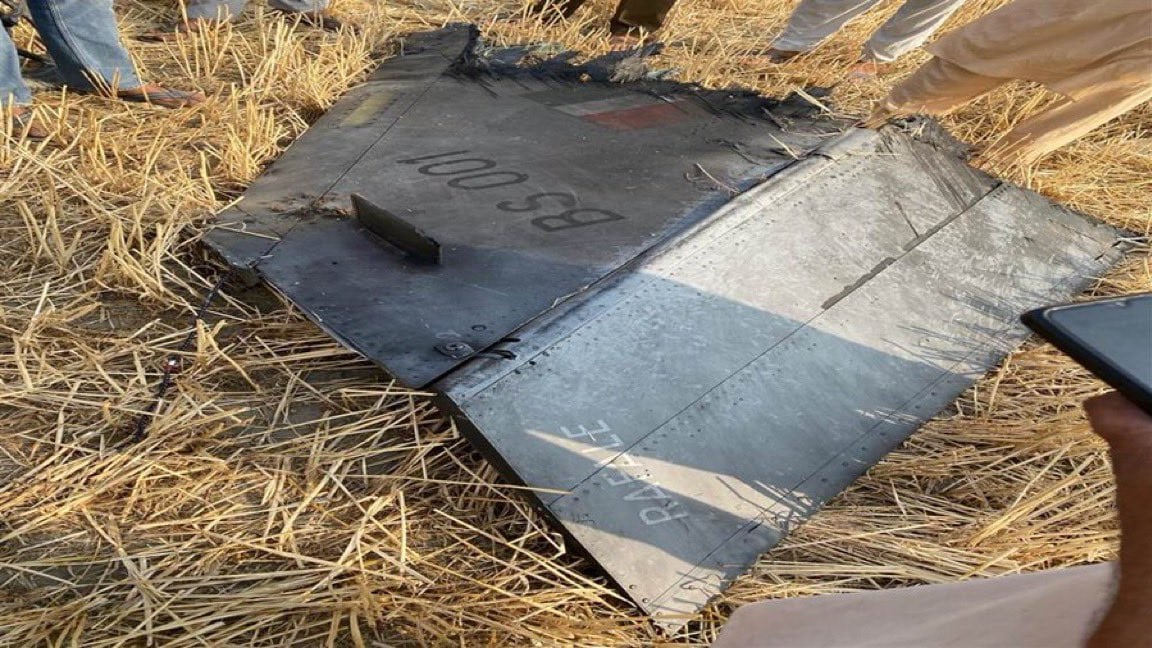
Subsequently, images of identifiable fragments from a SCALP-EG missile recovered on Pakistani territory also circulated widely on social media, further reinforcing claims about the weapon systems used.
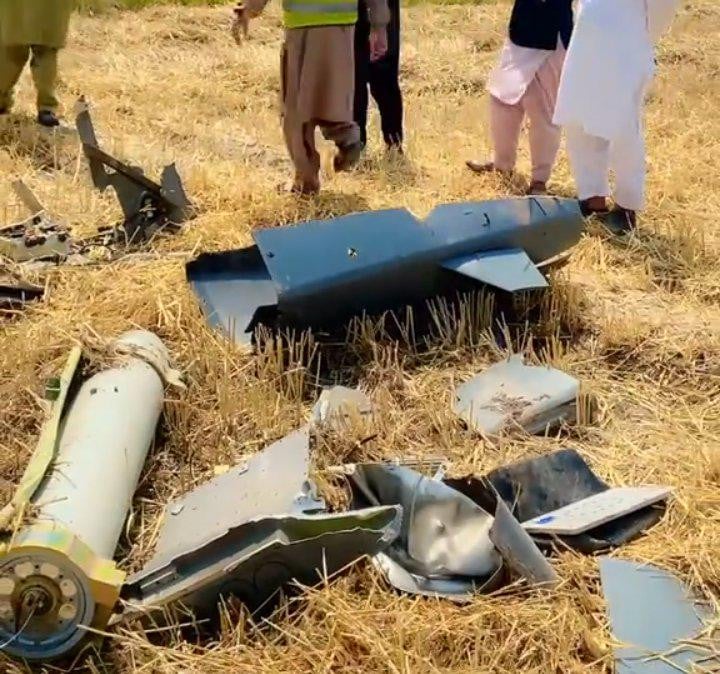
The SCALP-EG — designated the Storm Shadow by the United Kingdom — is a long-range, air-launched, stand-off cruise missile equipped with a multi-stage high-explosive warhead that weighs over 400 kilogrammes. Its warhead design combines an initial shaped charge with a secondary penetrating blast charge, allowing it to effectively strike hardened targets, such as underground bunkers, which would typically require specialised penetrating bombs.
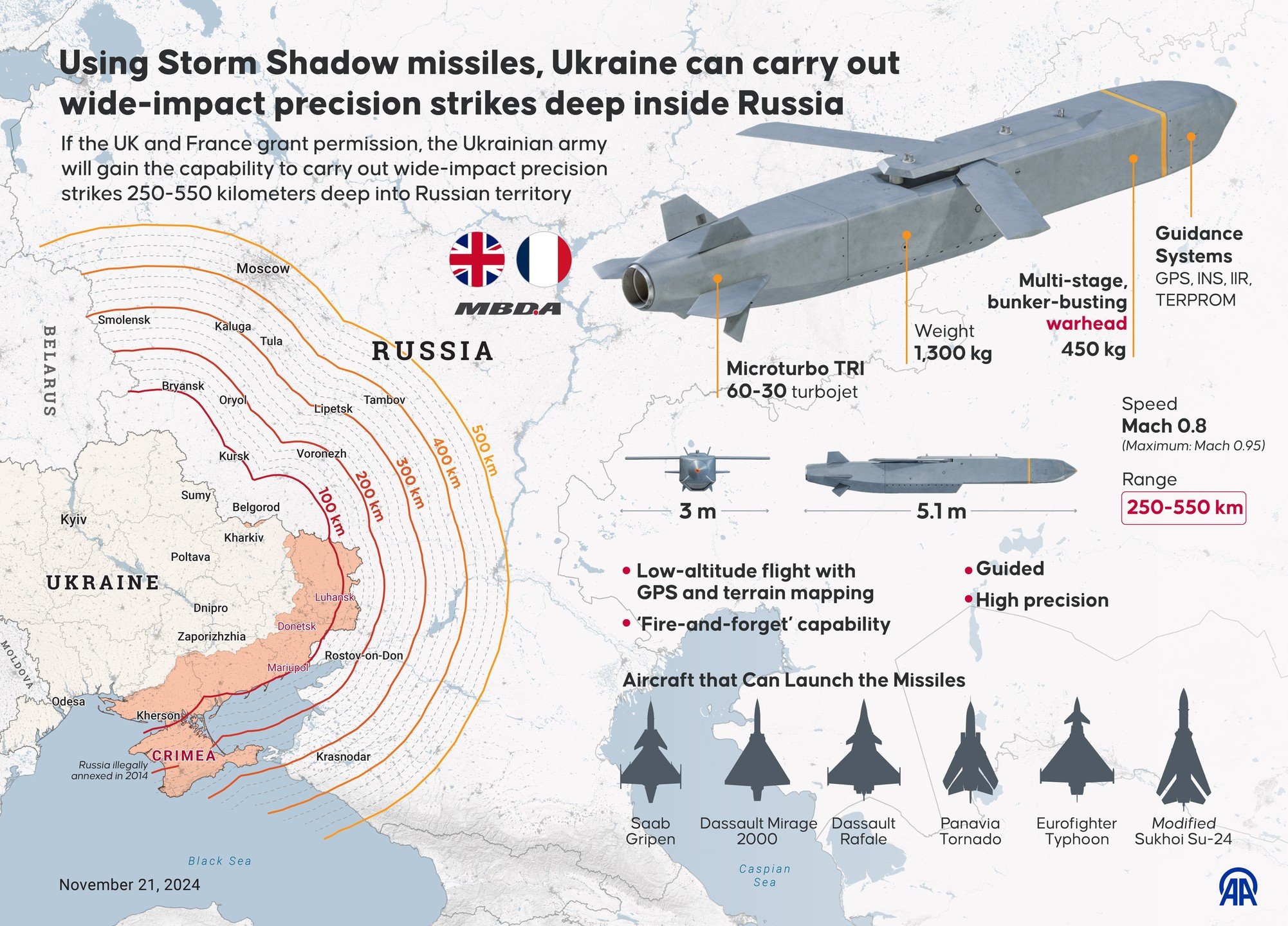
Both the SCALP-EG missiles and the Rafale fighter jets are exported under the terms of the European Union’s Common Position 2008/944/CFSP, which lays down eight legally binding criteria that EU member states must apply when assessing arms export licenses. These criteria are not optional guidelines, but legally binding obligations under EU law.
Of particular relevance are:
- Criterion 2, which mandates that EU member states must deny an export license if there is a clear risk the equipment might be used to commit serious violations of international humanitarian law (IHL) or human rights. The deliberate or indiscriminate targeting of civilian infrastructure — including places of worship and residential areas — would constitute such a violation;
- Criterion 3, which concerns the internal situation in the country of final destination, including the existence of tensions or armed conflicts. Given the volatile state of affairs in South Asia, and the frequent escalation between India and Pakistan, experts have long warned of the high risk that exported weapon systems could be used in active conflict zones;
- Criterion 4, which mandates consideration of whether the export might contribute to regional instability or aggravate existing tensions. India and Pakistan are both nuclear-armed states with a history of military stand-offs; supplying precision strike capabilities in such a context poses a foreseeable risk of destabilisation;
- and Criterion 7, which addresses the risk of diversion or re-export under undesirable conditions, but it also speaks to a broader responsibility on the part of EU member states to ensure that arms exports do not undermine peace or fuel conflict.
The use of EU-origin precision weapons in a cross-border strike on civilian areas — absent any independent verification of combatant presence — raises urgent legal, ethical, and political questions for the European Union. Was this a failure of due diligence or an inevitable outcome of certain European nations’ growing appetite for geopolitical influence through arms sales? Can EU member states credibly claim they had no reason to foresee the risk of misuse?
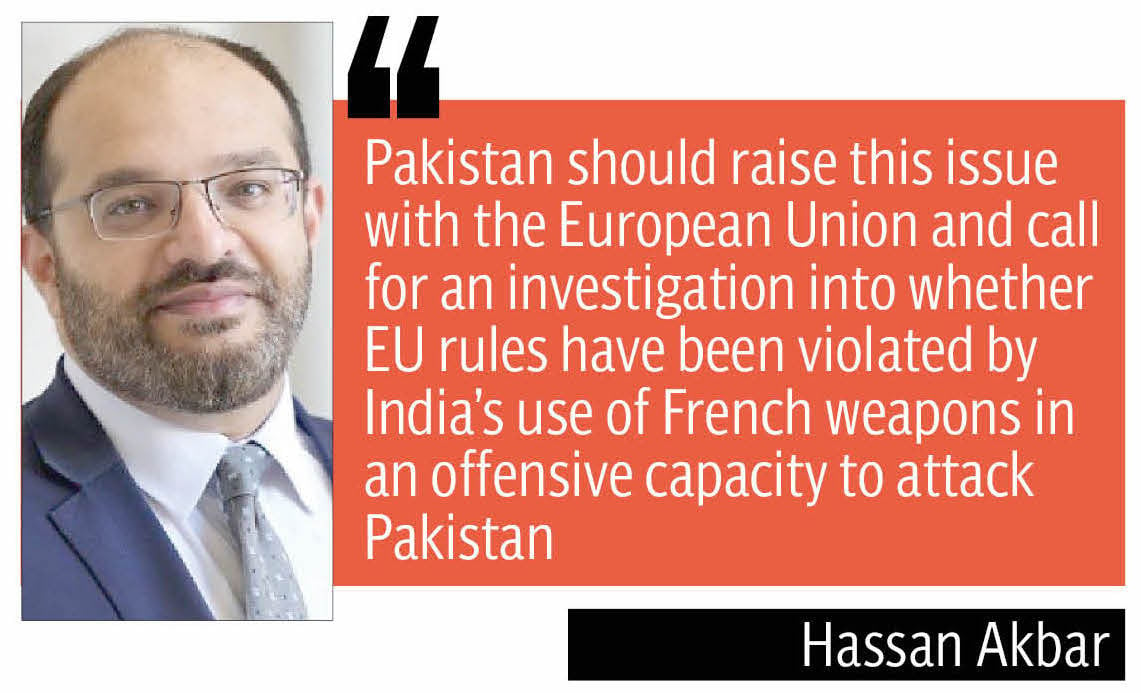
Collating the evidence
Speaking to The Express Tribune, Hassan Akbar, Pakistan Fellow at the Wilson Center, said that Pakistan should formally raise the issue with the European Union and call for an investigation into whether India’s use of French-made weapons violates EU export regulations.
“If it is assessed that this is the case,” Akbar argued, “Pakistan should urge the EU to demand an explanation from New Delhi, restrict future weapons exports, and impose stricter conditions on the transfer of arms and military technology.”
However, international law expert and former LSE fellow Dr Saadia Zahoor cautioned against drawing legal conclusions without first establishing the facts.
“First, the SCALP-EG missiles allegedly used by India are of French origin. I know there are images of wreckage circulating online, but for any diplomatic or legal engagement with a third party, we need conclusive, independently verified evidence, not just social media posts or unverified open-source claims,” she said.
Secondly, Dr Zahoor emphasised that under IHL, the key question is whether civilian deaths and damage to civilian infrastructure were intentional or disproportionate relative to the military objective. “Such determinations rely on verifiable facts and must be based on corroborated evidence. They cannot be built solely on legal interpretation without a solid evidentiary foundation,” she stressed, pointing out that India claims it targeted terrorist hideouts and any civilian casualties were incidental. “In fact, their official stance is that we are fabricating the narrative.”
Addressing India’s framing of its actions as self-defence in response to Pahalgam, Dr Zahoor said, “Convincing the international community otherwise requires a significant effort, especially since many Western countries tend to view such counterterrorism measures as justified.”
She further explained that while EU’s Common Position prohibits the use of EU-origin weapons for “external aggression,” this language appears in the preamble, which plays an important interpretative role but does not carry the same binding legal force as the operative provisions of the framework.
With that context laid out, Dr Zahoor noted that France is bound by several international frameworks that aim to protect international and regional peace, reduce human suffering, and promote transparency and responsibility in arms transfers.
“As a State Party to the Arms Trade Treaty (ATT), it must not authorise arms transfers if it has knowledge, at the time of authorisation, that the arms would be used to commit genocide, crimes against humanity, grave breaches of the Geneva Conventions, attacks against civilians or civilian objects, or other war crimes,” she explained. “France is also a participant in the Wassenaar Arrangement, which promotes transparency and alignment of export control policies… [and] under EU Council Common Position 2008/944/CFSP, France must assess eight legally binding criteria when authorising arms exports,” she said.
Dr Zahoor pointed towards Criterion 2 and Criterion 4 as the most relevant. In light of those, she said France is required to conduct a rigorous, evidence-based risk assessment before granting export licenses. “This includes evaluating whether there is a clear or substantial risk, commonly interpreted as a ‘more-likely-than-not’ threshold, that the export could contribute to violations of IHL, human rights, or regional instability.”
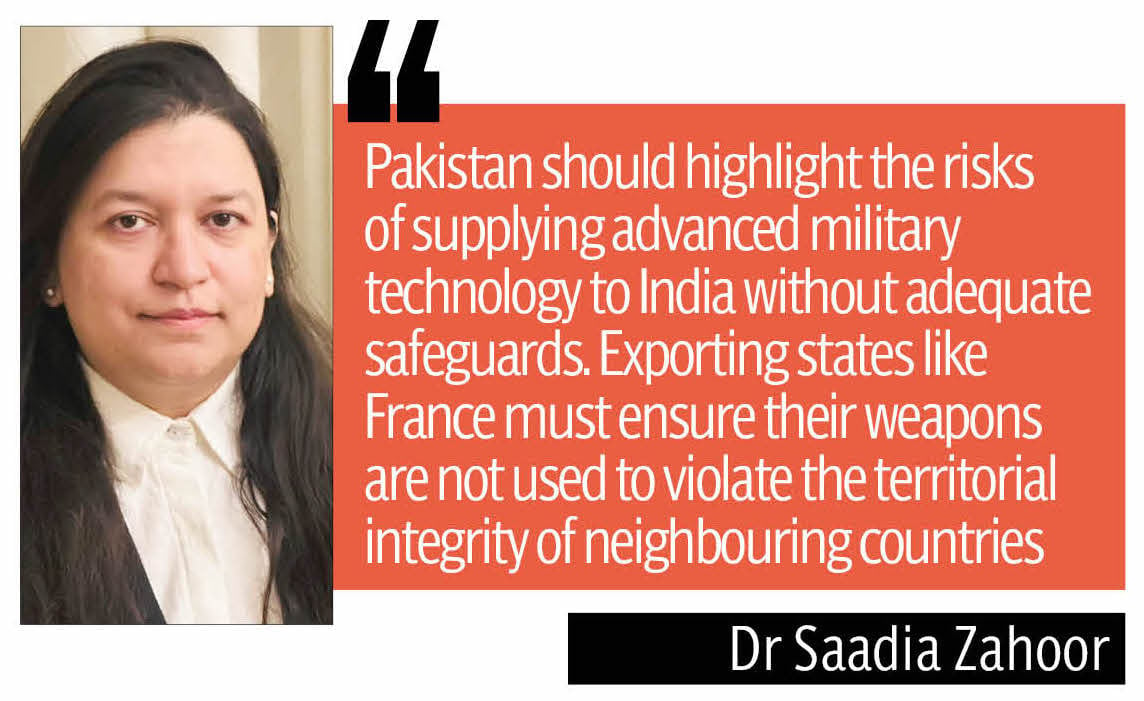
While India first announced its intention to procure Rafale jets and associated weaponry as early as 2012, and signed an intergovernmental agreement with France in 2016, the deal was stalled by controversy and corruption allegations until 2019 — the same year India initiated its last aerial skirmish with Pakistan.
That February, following an attack on Indian security forces in Pulwama, Indian jets crossed into Pakistani airspace and struck Balakot. Though the attack resulted in no casualties, Pakistan responded with Operation Swift Retort, downing two IAF jets and capturing one pilot, Wing Commander Abhinandan Varthaman. The pilot was later returned, easing tensions, but the episode underscored a recurring pattern of brinkmanship under a nuclear overhang by the Modi government.
Following the episode, Modi famously claimed that had India possessed the Rafale at the time, none of their jets would have been downed and none of Pakistan’s would have been spared — a remark that, in retrospect, hinted at his intent to strike Pakistan again in the future.
Speaking to The Express Tribune, Frank Slijper, Arms Trade Project Leader at PAX, one of the Netherlands’ leading peace organisations, said that given the history of armed skirmishes and political hostility between India and Pakistan, “a rigorous risk assessment” was required before transferring such high-precision weaponry to India.
However, he was frank about the gap between principle and practice. “There are no rules for revoking or suspending previously granted licences,” he explained. “But logically, any abuse of weapons in violation of the EU Common Position’s criteria would merit reconsideration — and could lead to freezing any still pending deliveries.”
The most pertinent of these criteria is Criterion 2, which requires that arms exports be denied if there is a “clear risk” they might be used for “serious violations of IHL.” If substantiated, India's reported targeting of civilian infrastructure could squarely fall under this provision.
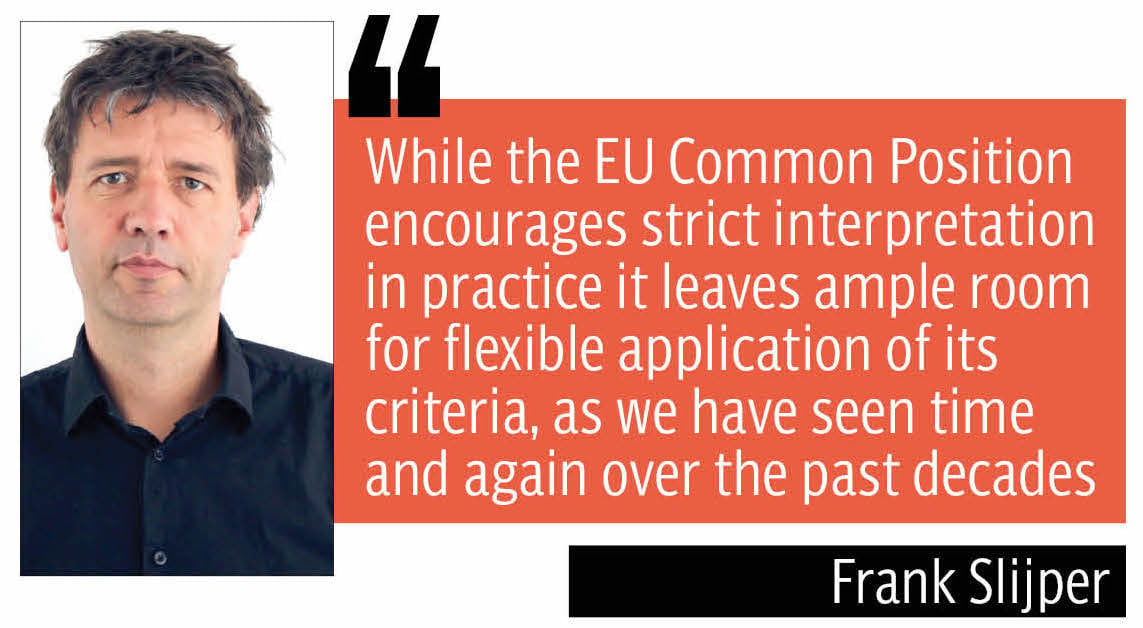
From evidence to action
Speaking about Pakistan’s available options, Dr Saadia Zahoor stressed that the first step must be a “factual investigation.”
“Was French-origin military equipment, such as SCALP-EG missiles or Rafale jets, used in cross-border strikes on civilian infrastructure following the Pahalgam incident? Were sites like schools, religious buildings, homes, or water infrastructure deliberately targeted? What was the nature, scale, and intent of the strikes?” she asked.
A credible legal argument, she noted, can only be built if it is factually demonstrated that French-supplied weapons were used to deliberately or disproportionately target civilians or civilian objects. “Only then can Pakistan credibly argue that France has violated its obligations under the ATT and the EU’s Common Position, particularly Criterion 2,” she said.
Dr Zahoor added that a broader legal argument could also be made under Criterion 4 of the Common Position, which focuses on regional peace, security, and stability.
“India’s longstanding territorial disputes and recurring tensions with Pakistan, combined with its recent procurement of advanced French military technology, suggest preparation for potential offensive operations — possibly even ground invasion,” she observed. “India’s interest in acquiring nuclear-powered submarines (SSNs) and expanding its naval capabilities with French assistance also raises concerns around non-proliferation and regional destabilisation.”
She further recommended that Pakistan draw attention to India’s human rights record, particularly in Indian-administered Kashmir and the northeastern states.
“Repeated reports of attacks on civilian homes, mosques, and water infrastructure raise serious questions under IHL. In addition, India’s treatment of Rohingya refugees has drawn criticism from the UN Office of the High Commissioner for Human Rights, which recently alleged that Indian authorities detained, blindfolded, and forcibly deported refugees — including individuals holding valid UNHCR documentation — abandoning them at sea. This raises serious red flags under both international human rights and refugee law,” she said.
Dr Zahoor noted that while it may be difficult to establish a direct causal link between specific weapons platforms and individual violations, these broader patterns should be central to France’s risk assessments under EU and international arms control frameworks.
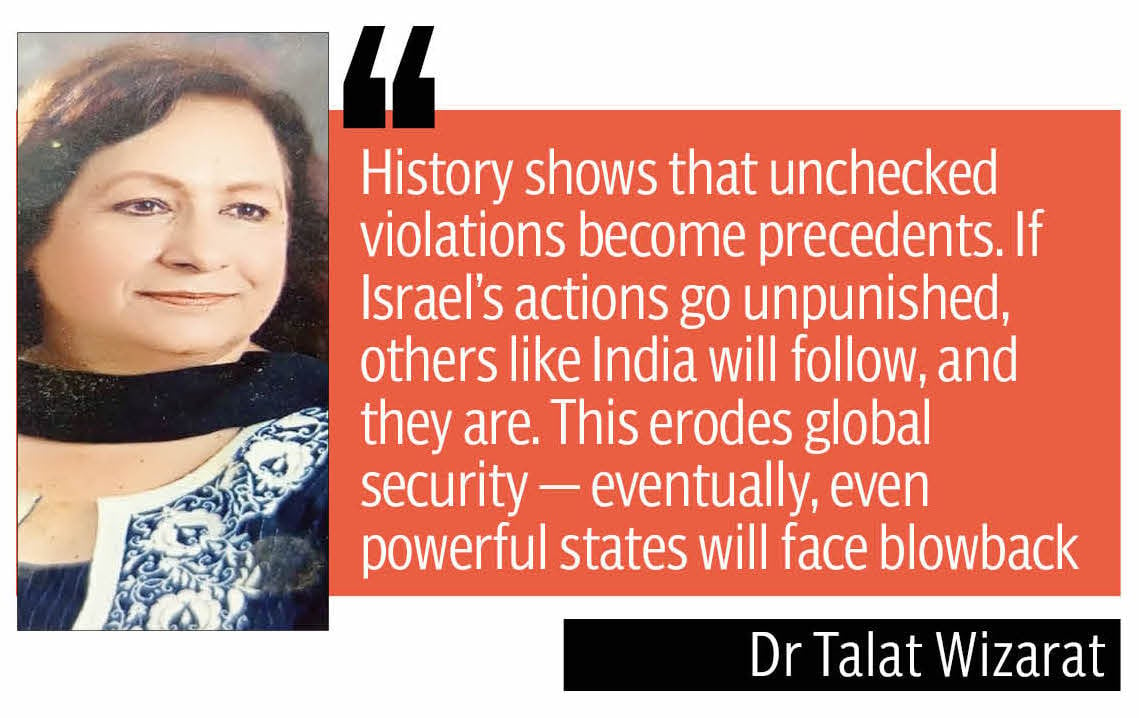
Speaking to The Express Tribune, Dr Talat Wizarat, former chairperson of the Department of International Relations at the University of Karachi, described India’s recent military strikes as part of a long-standing pattern of cross-border terrorism rather than a one-off act of aggression.
“India has been implicated in subversive activities in multiple countries, including Australia and several European nations,” Dr Wizarat said. “Make no mistake that India resorted to targeting civilians — schoolchildren, public spaces, and military installations. And that qualifies as cross-border terrorism, an aggressive violation of another nation's sovereignty.”
Framing the recent strikes in Pakistan and AJK as part of a broader geopolitical strategy, Dr Wizarat argued that New Delhi has historically used proxy actors and covert operations to destabilise its neighbours, citing India’s past support for the Tamil Tigers in Sri Lanka as a notable example. “This isn’t isolated — it’s a pattern,” she said. “India used the Tamil Tigers to destabilise Sri Lanka until Pakistan intervened to help restore stability.”
The cumulative toll for Pakistan, she noted, extends beyond physical devastation. “The consequences are severe — loss of human life, reputational damage as India continues to brand us as a terrorism hotspot, and that stifles economic potential. We could be a thriving tourist destination, but insecurity deters investment and growth.”
Building on this groundwork, Pakistan can and should make formal diplomatic representations to France and other EU Member States, arguing that continued arms exports to India violate both the EU’s Common Position and the ATT, Dr Saadia Zahoor said.
“France has a legal obligation to assess India’s compliance with IHL. A fair and objective risk assessment should underscore the likelihood that French-supplied military technology could be used to commit or facilitate serious violations of IHL. This should trigger the application of Criterion 2, leading to the suspension or denial of export licenses,” she explained.
In the absence of a full suspension, Pakistan could also advocate for conditionality measures — such as usage restrictions or enhanced end-use monitoring — on French-origin military equipment, Dr Zahoor suggested.
“These safeguards could help mitigate the risk of nuclear escalation and ensure compliance with international legal norms. However, any such demands must be backed by credible, independently verifiable evidence — whether of past misuse or credible indicators of future risk,” she cautioned.
She also recommended that Pakistan stress, through diplomatic channels, the real risk that EU-supplied weapons could be used in future offensive operations in AJK or Gilgit-Baltistan.
“India’s stated intentions to challenge Pakistan’s water rights under the Indus Waters Treaty and customary international law should also be flagged. If EU-origin weapons are deployed in such scenarios, it would directly contradict the EU’s legal obligations under international law and the domestic export control laws of Member States,” Dr Zahoor said.
“In the event of concrete evidence of violations (and intensity), Pakistan may also consider supporting legal actions in French courts, either through local civil society organisations or diaspora groups,” she added.
“History shows that unchecked violations become precedents. If Israel’s actions go unpunished, others like India will follow — and they are,” said Dr Wizarat. To prevent this pattern from becoming the norm, she urged Pakistan to pursue a firmer and more proactive international strategy. “To stop India, Pakistan must respond firmly and rally international support. The world must correct past failures by upholding international law uniformly, not selectively.”
She called on Islamabad to take the fight to multilateral forums, engage with global media, and present irrefutable evidence of Indian violations. “Statements aren’t enough. We need a sustained, evidence-backed campaign. India weaponises its media and global connections to spread disinformation; Pakistan must counter with verified proof — like the confessions of Kulbhushan Jadhav, an Indian agent operating here.”
“We must engage international media, present dossiers to multilateral forums, and demand action. Silence only emboldens the regime in India,” Dr Wizarat added.
Profits over principles?
Despite its robust legal framework, the EU’s arms export control system faces significant challenges in enforcement and transparency, with commercial and geopolitical interests often taking precedence over humanitarian concerns.
Experts argue that the EU’s export control architecture might lack teeth when it comes to retrospective accountability. The EU Common Position, despite being legally binding, lacks centralised enforcement mechanisms, leaving compliance to the discretion of individual member states.
“The EU Common Position is the EU-wide endorsed policy with a strong legal background. But any decision-making on arms exports is a national competence,” explained Frank Slijper.
This decentralisation could undermine the effectiveness of the Common Position. While the Working Party on Conventional Arms Exports (COARM) may trigger peer pressure from other member states, there is no EU-level body with authority to revoke licenses, sanction violations, or intervene when member states’ exports contravene the spirit or letter of the Common Position.
“While the EU Common Position encourages strict interpretation, in practice it leaves ample room for flexible application… The lack of enforceability leaves little more than peer pressure — which the largest exporters like France and Germany are generally insensitive to,” Frank Slijper pointed out.
Although he conceded that the Common Position could in theory serve as grounds to hold an exporter like France responsible, “it’s unclear which court would deal with it.”
While civil society groups like PAX, Amnesty International and Human Rights Watch routinely investigate misuse of exported weapons, institutional mechanisms within the EU — such as COARM, the Working Party on Conventional Arms Exports — have little authority to compel member states to act. “Any inquiry at the EU level is unlikely,” says Slijper. “Ultimately, arms exports remain a sovereign national decision.”
In practice, this means France is under no obligation to reassess or suspend exports to India unless it chooses to do so unilaterally. And that, Slijper suggests, is unlikely unless faced with sustained pressure from civil society and media. “Mostly it’s the civil society organisations or the media — or a combination of both — that puts pressure on capitals like Paris,” he says.
This systemic opacity makes it difficult to determine whether commercial and geopolitical interests are overriding humanitarian considerations. Slijper noted that risk assessments are “not transparent,” and that arms control frameworks are often bypassed in practice when lucrative arms deals are at stake.
Legally, arms exports are authorised by national governments. Yet Frank Slijper argues that manufacturers are not absolved of responsibility once licenses are granted. “Morally, of course, they are liable,” he says. “Companies have their own individual responsibility to ensure that whatever they do in their business is coherent and in line with international law.”
This is not just a matter of ethics. Under the UN Guiding Principles on Business and Human Rights and the OECD Guidelines for Multinational Enterprises, companies are expected to conduct human rights due diligence — including an assessment of whether their products may be used in ways that cause or contribute to harm. Slijper notes that such due diligence would be especially vital when supplying advanced weaponry to a state involved in an unresolved territorial conflict like that between India and Pakistan.
And yet, even in the face of civilian casualties, accountability remains elusive. Arms manufacturers often invoke the legitimacy conferred by a government-issued export license. “That’s clearly not sufficient,” Slijper asserted. In fact, these firms can and should go further: “They can refuse follow-up orders. If the country that used the weapons is seeking to restock due to an ongoing conflict, then it becomes a very pressing matter.”
France, for its part, could also take a stand. While the Common Position leaves enforcement to individual member states, there is nothing preventing France from demanding usage clarifications, placing conditions on further exports, or even suspending deliveries in response to credible allegations of misuse.
However, Slijper noted, “Any company and any government can ask those questions… The issue is whether India would agree — and whether France is willing to potentially sacrifice a lucrative deal.”
Thus far, the answer appears to be no based on other recent conflicts. “The precedent has already been set by Israel, Saudi Arabia, and other conflicts in Ethiopia and Sudan,” warned Slijper. “It shows the erosion of international norms that we have created over the past 75 years.”
For Dr Saadia Zahoor, the case represents a classic clash between the rule of law and economic interests.
“On one hand, countries like France are among the world’s top arms exporters. According to the SIPRI, France became the second-largest global arms exporter in 2024, with India as its largest customer,” she said. “In contrast, Pakistan is not a major buyer of French or European arms. So regardless of any geopolitical tensions, India has the purchasing power, and European states may be reluctant to publicly confront or admonish India out of concern for losing a key defence market.”
At the same time, she highlighted the strong action from European civil society and courts in response to arms exports linked to potential violations of international law, most notably in relation to Israel. “So it wouldn’t be surprising if India eventually faces similar scrutiny, no matter how much it positions itself as a regional hegemon,” she said.
Dr Zahoor also pointed out that the EU and its member states don’t always act uniformly. According to her, the French and Dutch cases illustrate this divergence: “Despite France’s international legal obligations, it has continued exporting arms to countries like Saudi Arabia and the UAE, whose conduct in the Yemen conflict has been widely reported and condemned for serious violations of IHL. From 2015 to 2022, France exported over €21 billion in arms to these countries,” she said.
“In 2021, several civil society groups filed a legal challenge before the Paris Administrative Court, questioning the legality of these exports. The case, including a subsequent priority constitutional question, was dismissed in July 2024. The outcome highlighted a troubling lack of transparency and judicial oversight in France’s arms export system, and underscored the gap between legal standards and political practice,” Dr Zahoor recalled.
Meanwhile, the Dutch judiciary took a very different approach, she explained. “On 12 February 2024, the Court of Appeals in The Hague ruled that the Netherlands must halt the export of F-35 fighter jet parts to Israel. The court found that these exports violated both the EU Common Position and the ATT, due to a clear risk of IHL violations. The case, brought by Oxfam Novib, PAX, and The Rights Forum, pointed to Israel’s use of F- 35s in attacks failed to adequately protect civilians. The court ordered the Dutch government to suspend the exports within seven days, setting a powerful precedent for judicial engagement in arms control.”
According to Dr Zahoor, while the EU as a bloc might hesitate to directly challenge India due to strategic and economic interests, national-level responses, especially through the courts, could still play a significant role, depending on the strength of the evidence and public pressure.
Frank Slijper too pointed out that there is precedent for national arms sales suspensions, such as the Netherlands halting exports to both India and Pakistan following the 1998 nuclear tests, or more recently, court cases initiated by civil society groups in the Netherlands and Germany over exports to Israel and Saudi Arabia. But such actions are rare and typically reactive, triggered by public outcry rather than systemic EU scrutiny.
Moreover, COARM itself lacks transparency. Its proceedings are closed to the public, and member states are not required to disclose how they interpret or apply export criteria, even in the face of possible breaches. This opacity fuels concerns that commercial and geopolitical considerations often trump humanitarian principles — especially in dealings with strategic partners like India.
Slijper underscores the danger of this drift. “These assessments are not transparent,” he said “and often these other interests appear to be overriding.” Left unchecked, this approach seems to erode the EU’s normative position on human rights and the rules-based international order it seeks to champion.
Asked what reforms might be necessary to prevent EU-origin weapons from being implicated in violations of IHL, Dr Saadia Zahoor pointed to recent changes to the EU Council Common Position 2008/944/CFSP. “The most recent amendment, introduced through Council Decision (CFSP) 2025/779 in April 2025, includes important updates — most notably, a greater emphasis on enhanced end-use monitoring,” she said, explaining that under the amended Article 5, EU member states now have the explicit authority to impose stricter end-use conditions on arms exports.
“These changes could lead to exporters being required to include clauses for on-site inspections or usage reporting as part of the license approval process. While this may sound new in the EU context, the concept isn’t entirely novel, similar on-site verification mechanisms exist in international arms control regimes, such as those governing nuclear, chemical, and biological weapons,” said Dr Zahoor.
In practical terms, this means defence manufacturers would need to incorporate compliance provisions into their contracts and support verification efforts throughout the lifecycle of their products. However, despite recent legal progress, post-shipment controls — such as on-site inspections — remain rare and difficult to implement, Dr Zahoor noted. “They often require physical access to the recipient state's territory, which may not always be politically or logistically feasible.”
“For the EU to uphold its commitment to preventing its arms from facilitating violations of IHL and IHRL, member States will need to significantly strengthen their monitoring practices,” she added. “This requires not only legal reforms, but also the political will and adequate resources to enforce them effectively.”
The cost of strategic blindness
Dr Talat Wizarat took a harsher line on EU’s inconsistent stance on human rights and international law, especially in the context of its arms trade. “The EU, much like the US, prioritises profit over principles,” she said. “They sell arms, turn a blind eye to atrocities and cling to a hollow reputation as human rights defenders. This hypocrisy must be challenged collectively.”
In her view, the EU’s inaction — despite the alleged use of its weapons in civilian strikes — mirrors its complicity in arming Israel, whose conduct in Gaza has drawn international condemnation.
“Palestine lacks leverage, but other affected nations — including Pakistan — should diplomatically pressure the EU. Public exposure and media campaigns could force accountability. The world cannot tolerate selective enforcement of international law.”
Dr Saadia Zahoor concluded on a cautionary note: “India may be attempting to establish a ‘new normal’ in its posture toward Pakistan. But such precedents are not new. We’ve already seen them from Israel, Saudi Arabia and the UAE.”
She warns that counterterrorism rationales have increasingly been used to justify force in disputed or occupied territories. “Pakistan should reject this framing outright. This [Operation Sindoor] was not a counterterrorism operation — it should be presented as an act of aggression and a potential precursor to broader escalation.”
“Pakistan should also highlight the risks of supplying advanced military technology to India without adequate safeguards. Exporting states like France must ensure their weapons are not used to violate the territorial integrity of neighboring countries,” she added, “especially when the recipient refuses to provide credible evidence to justify such actions.”
While existing contracts may not include provisions for on-site inspections, the amended Common Position now permits EU Member States to enhance end-use monitoring, according to Dr Zahoor. “In the absence of formal mechanisms, the EU can still rely on open-source intelligence, satellite imagery, and independent investigative reports to determine whether French-made weapons were used by India during Operation Sindoor in violation of IHL principles,” she said. “This would help the EU uphold its legal and moral obligations and preserve the credibility of its arms export control regime.”
